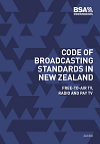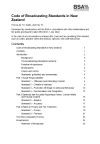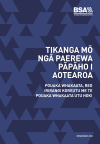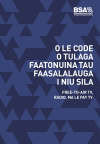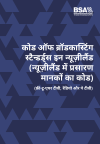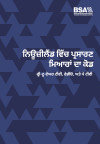The Broadcasting Act 1989 (the Act) creates a system of broadcasting standards. This Code provides guidance to all broadcasters (including those on radio, free-to-air television and pay television) and their audiences on the standards. Until this Code was introduced there were separate codes for each platform and there remain important differences which are acknowledged and reflected where appropriate. There is a separate code for election programmes.
The Standards
Part 1 - Social Responsibilities
Broadcast content should not seriously violate community standards of taste and decency or disproportionately offend or disturb the audience, taking into account:
-
the context of the programme and the wider context of the broadcast, and
-
the information given by the broadcaster to enable the audience to exercise choice and control over their own, and children’s, viewing or listening.
Guidelines
General
1.1 This standard regulates broadcasts that contain sexual material, nudity, violence or coarse language, or other material that is likely to cause offence or distress.
The context in which such content occurs and the wider context of the broadcast are important when assessing whether a broadcast has breached standards. This may include:
- the public interest1 in the programme
- the nature of the broadcast
- the broadcast’s classification (where relevant)
- the time of broadcast (for radio and free-to-air television)
- any audience advisories/warnings
- the target and likely audience
- audience expectations of the programme and the channel/station
- other information available to the audience about the content, including publicity and promos
- the level of the broadcaster’s editorial control over the programme (including whether the broadcast was live or pre-recorded, or received via a pass-through channel)
- any steps taken by the broadcaster to mitigate the impact of potentially offensive material broadcast unexpectedly or inadvertently (for example by a third party)
- any other protections available, for example filtering technology.2
1.2 For radio programmes:
- Talkback is an opinionated environment and is granted some latitude to be provocative and edgy in the interests of robust debate.
- If seriously offensive material from a third party is inadvertently broadcast, it is less likely to breach the standard if the host immediately redresses the issue.
Audience choice and control
1.3 Where broadcasters provide consistent, reliable information to audiences about the nature of their programmes, and enable them to exercise choice and control over their own and their children’s viewing or listening, they are less likely to breach standards.
Classification of television programmes
1.4 Television programmes must be classified correctly, with the following classifications broadcast on all content except news, current affairs, sports and live content:
G – General: Approved for general viewing: | G – Arowhānui: Kua whakaaetia mō te mātakitaki a te katoa: Programmes which exclude material likely to be unsuitable for children. Programmes may not necessarily be designed for child viewers but should not contain material likely to alarm or distress them.
PG – Parental Guidance: Parental Guidance recommended for younger viewers: | PG – Tohutohu ā-Matua: E tūtohua te Tohutohu ā-Matua mō ngā kaimātakitaki tamariki ake: Programmes containing material more suited for mature audiences but not necessarily unsuitable for child viewers when subject to the guidance of a parent or an adult.
M – Mature Audiences: Suitable for mature audiences 16 years and over: | M – Ngā Kaimātakitaki Pakeke: E tika ana mā ngā kaimātakitaki pakeke 16 tau, pakeke atu: Programmes might contain violence, sexual material, offensive language, adult themes, nudity, or other content that some children and adults find challenging. May contain material with a moderate impact and themes that require a mature outlook.
16 – People under 16 years should not view: |16 – Kaua e mātakina e te hunga i raro i te 16 tau: Programmes containing stronger material or special elements which are outside the M classification. May contain a greater degree of sexual material, offensive language, realistic violence and stronger adult themes.
18 – People under 18 years should not view: |18 – Kaua e mātakina e te hunga i raro i te 18 tau: Programmes containing themes which may be challenging or offensive even to some adult viewers.
1.5 News, current affairs, sports and live content is not, because of its distinct nature, subject to classification. This content is generally targeted at adults and it is expected any children watching or listening will be supervised. However, broadcasters must be mindful of children’s interests and other broadcasting standards and include audience advisories where appropriate, to enable the audience to exercise discretion.
1.6 Promos for television programmes should comply with the classification of the programme during which they screen.
Audience advisories (including warnings)
1.7 An appropriate advisory should be broadcast before content that is likely to be outside audience expectations, disturb children or offend or disturb a significant section of the audience.
1.8 What is appropriate in each case will depend on the broadcast platform, nature of the content and level of the broadcaster’s editorial control. An audience advisory may be:
- verbal only (on radio)
- one or more of the following advisory symbols (for television programmes):
- C – content may offend | C – ka mōrihariha pea ngā ihirangi
- L – language may offend | L – ka mōrihariha pea te reo
- V – contains violence | V – he whakarekereke kei roto
- S – sexual content may offend | S – ka mōrihariha pea ngā ihirangi hōkaka
- an additional written, or written and verbal, on-screen audience advisory (for a stronger level of television programming or content likely to disturb children).
Broadcasters may also choose to include helpline information where content focuses on, or depicts in detail, issues such as rape, sexual violence or suicide.
1.9 Advisories should be specific enough in nature to allow audiences to make an informed choice about their, and their children’s, exposure to content, while avoiding detail which itself may disproportionately disturb or offend.
Displaying classifications and audience advisories for television programmes
1.10 Classifications and any audience advisory symbols (C, L, V, S), must be visible and able to be considered by the audience. These must be displayed:
- at the beginning of programmes classified G or PG
- at the beginning of programmes, and (for free-to-air TV) after each break for content classified M, 16 or 18.
1.11 For television programmes, classifications, audience advisories/advisory symbols (if any) and a description of the programme should also be included in electronic programming guides, and printed guides where possible.
1.12 For pay TV, it is recognised that it will usually be impractical to display audience advisories for foreign pass-through channels with no or very limited editorial intervention.
Responsible scheduling
1.13 Broadcasters must schedule programmes responsibly, giving careful consideration to the likely and target audience, children’s interests, the audience’s ability to exercise choice and control, and all applicable standards.
1.14 For pay TV, especially where filtering technology is available, responsible scheduling is generally more about making sure the programmes on any channel are appropriate to the target audience for, or genre of, that channel rather than the time at which a programme is broadcast, and it is recognised that the broadcaster does not schedule the programmes on pass-through channels.
1.15 Where effective filtering technology is available to the audience and regularly promoted by the broadcaster, complaints about scheduling of television programmes are less likely to be upheld.
1.16 For free-to-air programmes:
- G and PG programmes may be screened at any time.
- M programmes may be screened between 9am and 3pm on weekdays (except during school and public holidays, as designated by the Ministry of Education) and after 7.30pm until 5am.
- 16 programmes may be screened after 8.30pm until 5am.
- 18 programmes may be screened after 9.30pm until 5am.
- Broadcasters should exercise discernment when scheduling content classified M, 16 and 18, including during any transition from G or PG programming to M, 16 or 18 programming.
- Broadcasters should consider children’s interests in scheduling promos for adult programmes (M, 16 or 18) during children’s normally accepted viewing times (see Guideline 2.1) and during programmes specifically aimed at child viewers so that the promo’s themes and content are not inappropriate for the programme classification.
1.17 For pay/subscription programmes:
- Programmes classified G, PG, M or 16 may screen at any time, so long as other applicable broadcasting standards are adhered to.
- Programmes classified 18 may screen at any time on premium channels,3 so long as other applicable broadcasting standards are adhered to.
- Content classified 18 may screen at any time on other channels, so long as filtering technology is available free of charge and regularly promoted to the audience, and other applicable broadcasting standards are adhered to.
- If filtering technology is not available, programmes classified 18 may screen only between 8pm and 6am, or 9am and 3pm (other than weekend days, school holidays and public holidays when they may screen only between 8.30pm and 5am).
- Explicit adult sex programmes classified 18 may screen only on premium channels.
Commentary
General
The purpose of this standard is to protect audiences from viewing or listening to broadcasts that are likely to cause widespread disproportionate offence or distress or undermine widely shared community standards.
Attitudes differ widely and continue to evolve in New Zealand’s diverse society. Caution must therefore be exercised when considering matters of taste and decency. The feelings of the particularly sensitive cannot dictate what can be broadcast. However, broadcasts must not seriously violate community norms or disproportionately disturb the audience.
Context is crucial
The context may justify the inclusion of challenging material or minimise its harmfulness. For example, the timing of a broadcast is relevant on free-to-air TV which has timebands, but not for pay TV which does not. Pay TV operates in a less restrictive environment due to the choice customers make in paying to receive broadcasts. Challenging material broadcast late at night, on a news programme or as part of a dramatic narrative, is more likely to be acceptable. So is challenging material that advances our understanding of important issues. We also recognise that violence has more impact when depicted visually on TV. Each case will depend on its particular facts and context.
Choice and control
The ability of an audience to choose what it views or listens to and to prevent children and young people from viewing/hearing inappropriate material is a significant factor in determining what is acceptable. Violent and other potentially offensive or disturbing material is readily accessible in our society and it follows that some material of this kind will be broadcast. However, appropriate protections are needed to prevent its exposure to those who should not, or do not wish to, see or hear it.
Depending on the platform, broadcasters may provide appropriate protection through advisories/warnings, appropriate scheduling, timebands, classification, electronic programme guides and/or filtering technology allowing parents and caregivers to block certain content.
Where broadcasters have promoted filtering technology, this will be taken into account in assessing whether enough care has been taken to provide protection from harm.
Audience expectations are crucial. In addition to the expectations that can be established via the above tools, some programmes or broadcasters (eg radio stations) have established target audiences, for whom they legitimately select and schedule content. Talkback radio has become a separate category due to its robust and sometimes challenging nature, and different standards may apply to programmes of this kind.
Programme information – variation across platforms
Certain aspects of this standard differ across platforms. Primarily, the difference is in the application, or not, of classifications and timebands.
In the free-to-air TV context, there are clearly defined classifications and corresponding timebands (G, PG, M, 16 and 18). There are no timebands on radio, though it is recognised that children are more likely to be listening at certain times of the day (for example, before and after school, up until 8.30pm on weekdays, and on weekends). Pay TV uses the same classifications and audience advisories as free-to-air TV but is not restricted by timebands.
1 Public interest refers to a matter of concern to, or having the potential to affect, a significant section of the New Zealand population. It is more than something that merely interests the public.
2 Filtering technology refers to technology provided through a television, set-top box or other way that enables certain content to be restricted by the audience. Also known as parental lock, parental control, PIN code, rating lock or content filter.
3 Premium channel means a pay television channel that subscribers choose to subscribe to and pay a subscription fee for, in addition to the entry-level fee already paid for the basic provision of the pay or subscription service.
Broadcasters should ensure children1 can be protected from content that might adversely affect them.
Guidelines
General
2.1 Broadcasters should ensure children can be protected from content that might adversely affect them, during children’s normally accepted viewing or listening times – usually up until 8.30pm (especially before school and after school), and on weekends and public holidays. School time is not considered to be children’s viewing or listening time.
2.2 Material likely to be considered under this standard includes:
- sexual material or themes
- violent content or themes
- offensive language
- social or domestic friction
- dangerous, antisocial or illegal behaviour
- material in which children or animals are humiliated or badly treated
- graphic descriptions of people in extreme pain or distress,
which are outside audience expectations for the type of programme or the programme classification.
2.3 Context is an important consideration when assessing complaints under this standard, including, where relevant, the programme’s classification and any audience advisory, the time of broadcast, the target and likely audience, audience expectations, the availability of filtering technology and whether it has been promoted by the broadcaster, the public interest in the broadcast and any factors that mitigate the likely harm to children, such as humour or educational benefit.
Free-to-air and pay TV
2.4 Children may be protected through security systems, eg filtering technology. Where these are available, they should be clearly and regularly promoted to customers.
2.5 Content classified M or above, especially that containing sexual or violent material, should not screen adjacent to content aimed at children (on the same channel).
2.6 Themes and scenes in fictional content dealing with matters known to disturb children, such as domestic friction or the humiliation or ill-treatment of children, should be appropriately classified and scheduled. In the context of pay TV, this is generally about avoiding that type of content on channels targeted at children.
2.7 Any portrayal of realistic violence in content likely to be viewed by children should be scheduled and classified with care.
2.8 When programmes broadcast on free-to-air TV during children’s normally accepted viewing times (see Guideline 2.1) contain material which is outside audience expectations and likely to disturb children, a written or written and verbal audience advisory should be broadcast. The advisory should be specific in nature to allow parents or guardians to make an informed choice about their children’s exposure to the content, while avoiding detail which itself may disturb or alarm children.
2.9 In news, current affairs and factual programmes broadcast on free-to-air TV, disturbing or alarming material should be justified in the public interest. Broadcasters must use judgement and discretion when deciding the degree of graphic material to be included in news programmes and should broadcast an audience advisory when appropriate, particularly when children are likely to be viewing.
Pay TV
2.10 Content on pay TV not intended for children’s viewing should not be specifically promoted to children and should be screened in accordance with Standard 1.
2.11 Pay TV channels targeted at children should only contain content appropriate for children.
Radio
2.12 This standard will only apply to radio during times when children are likely to be listening (usually during children’s normally accepted listening times – see Guideline 2.1).
Commentary
The purpose of this standard is to enable parents and caregivers to protect children from material that disproportionately disturbs them, is harmful, or is likely to impair their physical, mental or social development.
It covers children viewing or listening to broadcasts. If a complaint raises fairness or privacy concerns about a child featured or referred to in a broadcast, it should be dealt with under those standards.
Depending on the platform, children’s interests can be served in a number of ways including through advisories/warnings, appropriate scheduling, timebands, classification and/or filtering technology allowing parents and caregivers to block certain content.
It is not possible or practicable for broadcasters to shield children from all potentially unsuitable content. The objective is to allow them to broadcast to a wide audience – or in the context of pay TV, to offer a range of content to niche audiences who choose to subscribe to special channels – while taking reasonable steps to protect children by providing viewers and listeners with information and filtering technology. Parents/caregivers share responsibility for protecting children and should use the information and tools available for this purpose. We expect all broadcasters who use filtering technology, or other means of controlling access to broadcast content, to inform viewers that it is available and how to use it.
The children’s interests standard is related to the offensive and disturbing content standard which takes into account the same contextual factors. However, there are differences in focus. The focus of this standard is on harm that may be unique to children; content that could be considered harmful to children may not be harmful or unexpected when considering the audience in general.
1 A ‘child’ is under the age of 14 years.
Broadcast content should not be likely to promote illegal or serious antisocial behaviour taking into account the context and the audience’s ability to exercise choice and control.
Guidelines
3.1 Context is crucial in assessing the programme’s likely practical effect. This may include considering whether relevant content:
- is justified by the context (see Guideline 1.1)
- is justified in the public interest, in news, current affairs and factual content, and does not include an unreasonable or unnecessary degree of graphic detail, particularly when children are likely to be watching or listening
- carries an audience advisory or advisory symbol where appropriate, which may include helpline information (see guidelines 1.7-1.9)
- is classified carefully, in the case of television programming (see Guideline 1.4)
- is scheduled responsibly (see guidelines 1.13-1.17)
- is factual or a fictional/dramatic work (fictional/dramatic works, as a form of creative expression, are unlikely to breach the standard).
3.2 The level of editorial control of the broadcaster over programme content will be an important consideration when assessing complaints under this standard. For example, broadcasters exercise no or very limited editorial control over content screened on foreign pass-through channels.
Alcohol promotion
3.3 In addition to compliance with laws or regulations relating to the promotion of alcohol (including the relevant Advertising Standards Authority Code), broadcasters should observe restrictions on the promotion of alcohol appropriate to the programme genre being broadcast.
3.4 Alcohol promotion may be in one or more of the following forms:
- promotion of an alcohol product, brand or outlet (‘promotion’)
- alcohol sponsorship of a programme (‘sponsorship’)
- advocacy of alcohol consumption (‘advocacy’).
3.5 Any alcohol promotion in a broadcast should be socially responsible including that it:
- must not encourage consumption by people who are under the legal age to purchase alcohol
- must not occur in programmes specifically directed at children
- must not dominate a broadcast
- must avoid advocacy of excessive alcohol consumption and portraying it as positive or desirable
- in the case of sponsorship, must be confined to the brand, name or logo, and exclude sales messages
- in the case of alcohol-sponsored programmes, must primarily promote the programme, with the sponsorship subordinate
- is not required to be excluded from coverage of an event or situation being broadcast where such promotion is a normal feature of that event or situation – so long as the above guidance is adequately considered.
Commentary
General
The purpose of this standard is to prevent broadcasts that encourage audiences to break the law, or are otherwise likely to promote criminal or serious antisocial activity.
Illegal activity
This standard does not stop broadcasters from discussing or depicting criminal behaviour or other law-breaking, even if they do not explicitly condemn it. It also does not prevent genuine criticism of laws or their enforcement by the courts or police. The standard is concerned with broadcasts that actively undermine, or promote disobedience of the law or legal processes.
Direct incitement to break the law is likely to breach this standard, if there is a real likelihood the audience will act on it. Broadcasts which condone criminal activity or present it as positive or humorous may have this effect. Explicit instructions on how to commit crimes may also undermine law and order.
Antisocial activity
Serious antisocial activity is contrary to the laws or customs of society to such a degree that a significant number of people would find it unacceptable (eg sexual violence, suicide, substance abuse). It involves actions which are likely to have consequences for people in the real world. It is broader than illegal activity and can include other antisocial behaviour (eg bullying real people in broadcasts).
Broadcast content should not encourage discrimination against, or denigration of, any section of the community on account of sex, sexual orientation, race, age, disability, occupational status or as a consequence of legitimate expression of religion, culture or political belief.
Guidelines
4.1 ‘Discrimination’ is defined as encouraging the different treatment of the members of a particular section of the community, to their detriment. ‘Denigration’ is defined as devaluing the reputation of a particular section of the community.
4.2 The importance of freedom of expression means:
- A high level of condemnation, often with an element of malice or nastiness, will usually be necessary to find a broadcast encouraged discrimination or denigration in breach of the standard. Broadcast content which has the effect of reinforcing or embedding negative stereotypes may also be considered.
- This standard is not intended to prevent the broadcast of material that is:
- factual
- a genuine expression of serious comment, analysis or opinion
- legitimate humour, drama or satire.
4.3 Context is an important consideration in assessing whether a broadcast has gone too far (see Guideline 1.1 for definitions of context). The following factors may also be considered:
- the language used
- the tone of the person making the comments
- the forum in which the comments were made; for example, a serious political discussion or a satirical piece
- whether the comments were repeated or sustained, or corrected or rebutted
- whether the comments made a legitimate contribution to a wider debate or carried public interest.
Commentary
The purpose of this standard is to protect sections of the community from verbal and other attacks, and to foster a community commitment to equality.
The standard does not apply to individuals or organisations, which are dealt with under the fairness standard.
Comments will not breach the standard simply because they are critical of a particular group, because they offend people or because they are rude. Allowing the free and frank expression of a wide range of views is a necessary part of living in a democracy.
Serious commentary, factual programmes, and legitimate drama, humour and satire, are valuable forms of speech and are unlikely to breach the standard unless they had the potential to cause harm at a level that justifies restricting freedom of expression.
The discrimination and denigration standard will be interpreted by reference to evolving community standards and section 6 of the New Zealand Bill of Rights Act 1990 (interpretation consistent with the rights and freedoms contained in the Bill of Rights is to be preferred).
Part 2 - Balanced and Accurate Reporting in News, Current Affairs and Factual Content
When controversial issues of public importance are discussed in news, current affairs or factual programmes, broadcasters should make reasonable efforts, or give reasonable opportunities, to present significant viewpoints either in the same broadcast or in other broadcasts within the period of current interest unless the audience can reasonably be expected to be aware of significant viewpoints from other media coverage.
Guidelines
5.1 Determination of a complaint under the standard involves two steps:
- The first step is to consider whether the standard applies. It will only apply where the subject matter is:
- an issue ‘of public importance’ (something that would have a significant potential impact on, or be of concern to, New Zealanders)
- ‘controversial’ (an issue of topical currency; which has generated or is likely to generate conflicting opinion; or about which there has been ongoing public debate – eg issues related to New Zealand political policy, public health and safety, public expenditure)
- ‘discussed’ in a news, current affairs or factual programme (eg investigative or in-depth work – brief news reports, programmes clearly focused on a particular perspective, or personal or human interest stories, may not amount to a discussion).
- The second step is to assess whether the broadcaster sufficiently presented significant viewpoints in the circumstances.
5.2 The standard allows for balance to be achieved over time, within the period of current interest. It does not require every significant viewpoint to be presented in every programme that discusses a particular controversial issue of public importance.
5.3 The standard does not require equal time to be given to each significant viewpoint on a controversial issue of public importance. Broadcasters should give a fair voice to alternative significant viewpoints taking into account the nature of the issue and coverage of that issue.
5.4 The requirement to present significant points of view is likely to be reduced, or in some cases negated, where:
- It is clear from the programme’s introduction and the way in which the programme is presented, that:
- the programme is not claiming, or intended, to be a balanced examination of an issue
- the programme is signalled as approaching the issue from a particular perspective
- the programme is narrowly focused only on one aspect of a larger, complex debate.
- The issue is raised only in a brief, humorous or peripheral way. This includes programmes such as straight news items, which simply report on events or developments rather than discussing a related issue. Conversely, the requirement to present significant points of view is likely to be increased where an issue is the focus of a serious, investigative or in-depth report.
- The audience could reasonably be expected to be aware of views expressed in other coverage, including coverage by other broadcasters or media outlets.
- In the context, the audience would not have expected alternative viewpoints to be presented.
- The broadcaster retained no or very limited editorial control over the programme content (eg news, current affairs and factual programmes broadcast on foreign pass-through pay TV channels).
5.5 Programmes broadcast on foreign pass-through pay TV channels over which the broadcaster retains no or very limited editorial control are not usually subject to the balance standard. This recognises the value in providing access to a breadth of perspectives and views, and the choice made by pay TV customers to pay to receive certain broadcasts. However, the standard may be applied where a broadcast presents a serious risk of material harm.
Commentary
The purpose of this standard is to ensure competing viewpoints about significant issues are available, to enable the audience to arrive at an informed and reasoned opinion.
A common sense approach should be taken – the practical reality is that programmes cannot be perfectly balanced, and this is not required.
The standard and guidelines reflect the present broadcasting environment in New Zealand and the increased flows of information available from sources and on topics of all kinds. Given the proliferation of information available to today’s audiences, complaints under this standard will rarely be upheld. However, it provides protection in cases where balancing viewpoints on controversial issues have not been available across time, different programmes or different media.
An issue will not be ‘controversial’ for the purposes of the standard simply because some continue to hold alternative views about it (eg climate change, vaccine safety).
The standard does not require news, current affairs and factual programming to be presented impartially or without bias. Within the limits established by this standard, broadcasters are free to promote or challenge particular ideas, philosophies or people (eg politicians).
A key consideration is what an audience expects from a programme and whether they were likely to have been misinformed by the omission or treatment of a significant perspective (eg where a significant perspective is presented with limited coverage or in a manner which undermines its validity).
Broadcasters should make reasonable efforts to ensure news, current affairs and factual content:
- is accurate in relation to all material points of fact
- does not materially mislead the audience (give a wrong idea or impression of the facts).
In the event a material error of fact has occurred, broadcasters should correct it within a reasonable period after they have been put on notice.
Guidelines
6.1 The requirement for factual accuracy does not apply to statements which are clearly distinguishable as analysis, comment or opinion, rather than statements of fact. However, broadcasters should still make reasonable efforts to ensure analysis, comment or opinion is not materially misleading with respect to any facts:
- referred to; or
- upon which the analysis, comment or opinion is based.
6.2 The standard is not concerned with technical or other points unlikely to significantly affect the audience’s understanding of the content as a whole.
6.3 The assessment of whether the broadcaster has made reasonable efforts to ensure accuracy includes consideration of the following, where relevant:
- the source of material broadcast (eg a reputable organisation or an authoritative expert; or social media or third-party content from a non-reputable or non-authoritative organisation or person which may require additional care or steps to be taken by the broadcaster)
- whether the broadcast was live or pre-recorded
- whether there was some obvious reason to question the accuracy of the programme content before it was broadcast
- whether the broadcaster sought and/or presented comment, clarification or input from any relevant person or organisation
- the extent to which the issue of accuracy was reasonably capable of being determined by the broadcaster
- the effect of any subsequent or follow-up coverage (eg where information has been updated or corrected as part of a developing story; or there is a delay between the time of broadcast and when the content has been accessed)
- the level of the broadcaster’s editorial control over the content.
6.4 Talkback programmes will not usually be subject to the accuracy standard. However, the accuracy standard may apply where, for example:
- the host makes an unqualified statement of fact
- analysis, comment or opinion presented by the host is materially misleading in the manner described in Guideline 6.1.
6.5 Programmes broadcast on foreign pass-through pay TV channels over which the broadcaster retains no or very limited editorial control are not usually subject to the accuracy standard. This recognises the value in providing access to a breadth of perspectives and views, and the choice made by pay TV customers to pay to receive certain broadcasts. However, the standard may be applied where a broadcast presents a serious risk of material harm.
6.6 Where an obligation to correct a material error of fact arises, the broadcaster may correct it in such manner as is reasonable (eg via broadcast or its website) taking into account:
- the nature and impact of the error
- whether the relevant topic is the subject of ongoing updates and developments in which the correction could appear
- the impact of any other media coverage on the likelihood of the audience being misled
- when the error is identified (and any impact of the passage of time on its newsworthiness).
Commentary
The purpose of this standard is to protect the public from being significantly misinformed. The standard recognises the important role broadcasters play in protecting New Zealanders from misinformation and disinformation. The selection of programmes, opinions and interviewees to feature is a matter of editorial choice. However, reasonable efforts must always be taken to avoid misleading the public with respect to matters of fact. This applies whether facts are stated directly or form the basis of an opinion.
The standard applies only to news, current affairs and factual programming:
- News and current affairs can usually be readily identified as such, taking into account the topic(s) being discussed, and what audiences would reasonably expect to be news and current affairs. News and current affairs programmes may still contain – and can reasonably be expected to contain – opinion and analysis (eg from political editors and other experts).
- Factual programmes are non-fiction programmes which contain information audiences might reasonably expect to be authoritative or truthful, such as documentaries which are presented as being trustworthy.
In assessing whether a statement was a statement of fact, or was analysis, comment or opinion (Guideline 6.1), the following factors may be relevant:
- the language used
- the type of programme (eg talkback can involve discussion of factual matters but is generally recognised as a robust environment focused on the exchange of opinions)
- the role or reputation of the person speaking
- the subject matter
- whether the statement is attributed to someone
- whether evidence or proof is provided.
A programme may be inaccurate or misleading, but nevertheless may not breach the standard, if the broadcaster took reasonable steps, for example, by relying on a reputable source (Guideline 6.3).
Part 3 - Rights to Privacy and Fair Treatment
Broadcasters should maintain standards consistent with the privacy of the individual.
Guidelines
Identification
7.1 The privacy standard applies only to identifiable living individuals.
7.2 In assessing whether an individual is identifiable, the following considerations apply:
- Individuals must be identifiable beyond family and close friends who would reasonably be expected to know about the matter dealt with in the broadcast.
- A combination of information in the broadcast and other readily and publicly available material may enable identification for the purposes of this standard (‘jigsaw identification’).
- An individual may be identifiable even if they are not named or shown or their identity is partially masked.
Disclosure of private information or material
7.3 Broadcasters should not disclose private information or material about an individual in a way that is highly offensive to an objective reasonable person in the position of the person affected.
Reasonable expectation of privacy
7.4 There must be a reasonable expectation of privacy in relation to the content disclosed. Factors relevant to this include, but are not limited to:
- whether the content is in the public domain
- whether the content is intimate, sensitive or traumatic in nature
- whether the individual could reasonably expect the content would not be disclosed
- the nature of the individual, ie:
- Public figures, particularly those exercising public power, and others who seek publicity, generally have lower reasonable expectations of privacy in relation to matters pertaining to their public roles.
- Children under the age of 16 can reasonably expect high levels of privacy.
7.5 A person will not usually have a reasonable expectation of privacy in relation to matters in the public domain but the public nature of such matters is not definitive.
7.6 While a person will not usually have a reasonable expectation of privacy in a public place (ie one generally accessible to, and/or in view of, the public) such an expectation may exist where it is objectively obvious from the circumstances that the individual is particularly vulnerable. For example, vulnerability may be higher for:
- people caught up in emergencies
- accident victims
- those suffering a personal tragedy or bereavement.
7.7 Broadcasters should not broadcast content obtained through intentional intrusion upon a person’s solitude or seclusion in a way that is inconsistent with a reasonable expectation of privacy.
Highly offensive disclosure
7.8 Factors relevant to determining whether disclosure of private information is highly offensive include, but are not limited to:
- whether the content is particularly embarrassing or has the potential to impact negatively on reputation
- whether the individual is particularly vulnerable
- the seriousness of the circumstances (eg the means by which the information was gathered, whether the broadcast was exploitative or gratuitous)
- whether the individual has made efforts to protect their privacy or has not consented to the broadcast
- whether the disclosure was made for the purposes of encouraging harassment.
Defences
7.9 It is a defence to a privacy complaint to publicly disclose matters of legitimate public interest. A matter of legitimate public interest is a matter of concern to, or having the potential to affect, a significant section of the New Zealand population (ie it is more than something that merely interests the public). For the defence to apply:
- The level of public interest must be proportionate to the seriousness of the breach of privacy.
- The public interest must relate to the disclosure of the particular information or recording that is alleged to breach privacy.
7.10 It is not a breach of privacy where the person concerned has given informed consent to the disclosure or intrusion. Informed consent is provided where the person:
- is aware they are contributing to the broadcast
- understands the true context and purpose of the contribution
- understands the nature of the consent and its duration
- freely agrees to contribute.
7.11 A parent or guardian, or other person aged 18 or over in loco parentis (standing in the shoes of the parent or guardian), can consent on behalf of a child under the age of 16 years, but the broadcaster must be satisfied that the broadcast is not contrary to the best interests of the child.
Commentary
The privacy standard aims to respect, where reasonable, people’s wishes not to have themselves or their affairs broadcast to the public. It seeks to protect their dignity, autonomy, mental wellbeing and reputation, and their ability to develop relationships, opinions and creativity away from the glare of publicity. However, it also allows broadcasters to gather, record and broadcast material where this is in the public interest.
Our expectations of privacy vary with time, culture and technology, which creates some difficult boundaries. For this reason, this guidance is not exhaustive and may require elaboration or refinement when applied to a complaint. The Authority may also consider privacy law developments in New Zealand and overseas in applying this standard.
Broadcasters should deal fairly with any individual or organisation taking part or referred to in a broadcast.
Guidelines
8.1 A consideration of what is fair, and the threshold for finding unfairness to an individual or organisation, may take into account the following factors:
- the nature of the content (eg news and current affairs, political content, factual, dramatic, comedic or satirical)
- the source of the content (eg whether the content was locally produced by or on behalf of the broadcaster, or sourced overseas)
- the nature of the individual or organisation (eg the threshold for finding unfairness will be higher for a public figure, politician, or organisation familiar with dealing with the media, as opposed to an ordinary person with little or no media experience; whether the individual or organisation is based in New Zealand or overseas)
- whether the programme would have left the audience with an unfairly negative impression of the individual or organisation
- whether any critical comments were aimed at the participant in their business or professional life, or their personal life
- the public significance of the broadcast and its value in terms of free speech
- the target and likely audience, and audience expectations
- whether the programme was live or pre-recorded
- the vulnerability of the individual.
8.2 Participants and contributors should be informed, before a broadcast, of the nature of the programme and their proposed contribution, except where justified in the public interest, or where their participation is minor in the context of the programme.
8.3 Whether informed consent was required or has been obtained from a participant or a contributor may be a relevant consideration in determining whether that participant or contributor was treated fairly (see guidelines 7.10 and 7.11 for what constitutes ‘informed consent’).
8.4 If a person or organisation referred to or portrayed in a broadcast might be adversely affected, that person or organisation should usually be given a fair and reasonable opportunity to comment for the programme, before the broadcast. What is ‘fair and reasonable’ will depend on the circumstances.
8.5 Doorstepping1 an individual or organisation as a means of obtaining comment will normally be unfair, unless all legitimate and reasonable methods of obtaining comment have been exhausted.
8.6 Edited excerpts should fairly reflect the tenor of the overall events or views expressed.
8.7 Broadcasters must not broadcast information obtained by misrepresentation or deception (including by hidden camera or covert recording device), except where justified by the public interest.
8.8 The use of prank calls as a legitimate expression of humour will usually be acceptable, but caution should be exercised to prevent undue harm to unsuspecting parties.
8.9 Individuals, and particularly children and young people, featured in a programme should not be exploited, humiliated or unfairly identified.
8.10 Where programmes deal with distressing circumstances (eg grief and bereavement) broadcasters should show discretion and sensitivity.
Commentary
The purpose of this standard is to protect the dignity and reputation of those featured in programmes. It does not address ‘fairness’ to the audience or whether issues/facts are ‘fairly’ or misleadingly conveyed (which are matters for the accuracy or balance standards).
Individuals and organisations have the right to expect they will be dealt with justly and fairly and protected from unwarranted damage. In assessing fairness, this right is weighed against broadcasters’ right to freedom of expression and their role in disseminating information in the public interest.
1 ‘Doorstepping’ refers to the filming or recording of an interview or attempted interview with someone, without any prior warning.
Download the Codebook
